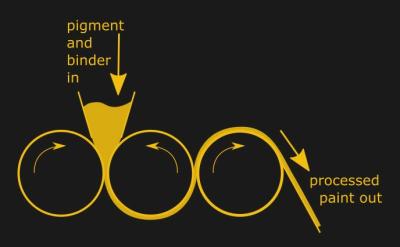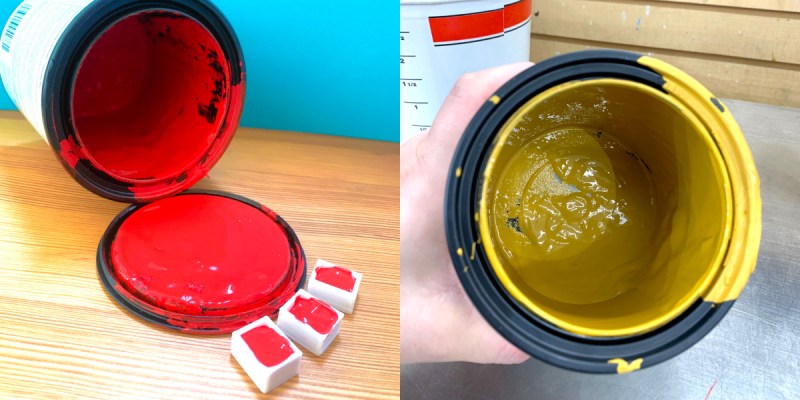How can the big box store mix the perfect shade of English Wedgwood right before your eyes? The answer is in highly-concentrated pigments that come in many different sizes up to a whopping five gallons. Now, just imagine the amount of watercolor, acrylic, or other types of paint that could be made by simply scraping the walls of an empty 5-gallon tub, which you know is just getting thrown away with all that usable pigment inside.
 Not only is [technoplastique] making watercolors and other paints out of these pigments, but their true focus is on creating an easily-reproducible process for turning not just pigments into paint, but other things as well, like dried turmeric, charcoal, or any other feasible material.
Not only is [technoplastique] making watercolors and other paints out of these pigments, but their true focus is on creating an easily-reproducible process for turning not just pigments into paint, but other things as well, like dried turmeric, charcoal, or any other feasible material.
The process will likely take the form of an open-source three-roller milling machine, which are commonly used in paint manufacture. Basically you have three rollers that process the pigment and binder, and the mixture is run through as many times as necessary. Although they are fairly simple machines in design, building them to work well requires adherence to precise technical specs.
We can’t wait to see what [technoplastique] comes up with to use for the stainless steel rollers. The rest of the plan involves a Raspberry Pi Pico, one DC motor per roller, a motor shield, and a power supply, but the rollers are pretty crucial. If you have any ideas other than steel rolling pins (the kitchen kind) or pipe couplings (which are too short, anyway), let us know in the comments!


















Plunder the corpse of a dying industry, doesn’t web offset printing such as used for newspapers and magazines use rollers for similar reasons? Guess plant sales would be the whole caboodle, not piece by piece though. If you can find a press that’s gone to the scrapper though…
Another avenue to explore would be gravity roller conveyors for the food industries.
> just imagine the amount of watercolor, acrylic, or other types of paint that could be made by simply scraping the walls of an empty 5-gallon tub
I did, and it’s not very much. Literally scraping the bottom of the barrel gives you like one button of water color? Two?
For the amount of effort spent, you won’t get a lot of painting done.
Don’t forget, these are pigments and not paint. Typically there would be only a few millilitres of pigment (if that) used in a 4 litre can of paint. Looking at the photo above, you’d likely get quite a few litres of paint out of those cans.
Come again?
If there’s only a few mills on pigment in a can, and you collect less than a percentage point of that from the residual, then reason says you only have a very small amount of pigment left. When you remove the solvent and press the solid pigment that into a water color button, you’re left with… what?
I think what’s going on here is that those aren’t the cans of paint that go out to the customer–they’re the cans of concentrated pigments that get *mixed into* the paint base to *make* the paint that goes out to the customer. If that’s the case, then ratio of pigment to not-pigment in those leftovers is MUCH higher than what you’d get in the final paint product.
A spoonful of pigment base could make a cup or a pint of paint.
…except that artist quality paints have a much higher concentration of pigment, so you’re back to not making a huge amount of paint.
Two different spots here I think are getting confused
Paints are usually only about 10-15% pigment (the rest being binders, solvents, etc), sometimes somewhat more for artist grade (up to like 20%-25%)
Paint shops regularly discard cans of pigment that still have a few oz of pigment in them; I work at one and we probably toss close to a quart every week or two.
So if you have a contact at a paint shop who can collect them instead of tossing them, you can use the waste to produce a decent amount of artist-grade paint; especially when you consider how much longer a quart lasts for an artist vs for painting a wall
Chemical photo processors as used for large format prints. If you can find one.
He’s using pigments for water-based paints, so I think is quite profitable to recover those pigments.
Rinsing the pigments in a lot of water to extract as much binde as posible could leave an exellent quality powdered binder.
You can also look for the pigment code to know exactly what chemical it is and make your formulations from there.
The roller mill is not a must, you could achive a great result usign Glass (or stone) Muller, it’s labor intensive, but for small quantities it can be done quickly.
If you want a small milling machine, see if you can get one from a compounding pharmacy (that stops compounding, or stops altogether). Pharmacies use mills like this to (further) homogenize ointments and creams, when there are conglomerates of active ingredient in the base.
Don’t those mills come with polymer rollers? they might be too soft for pigments.
I’m also wandering the price tag for anything made for pharmaceutical industry